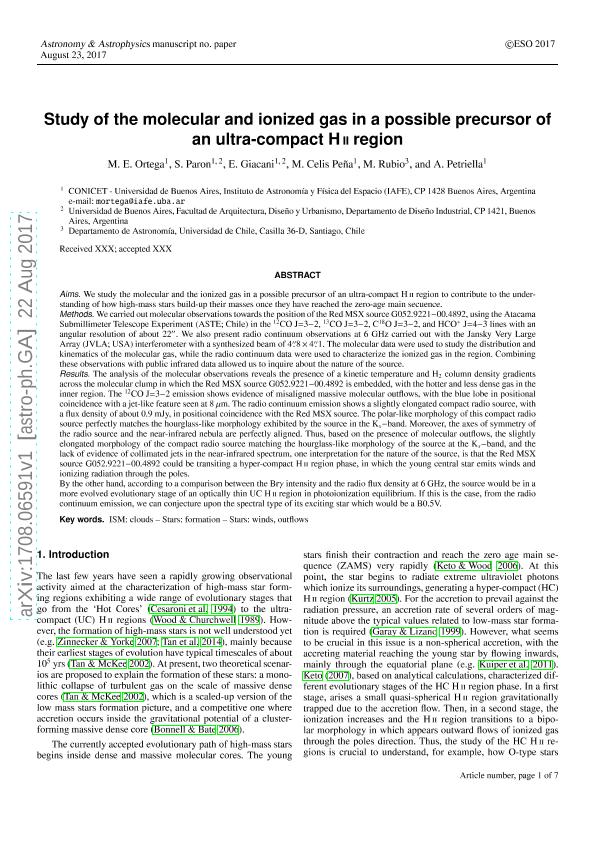Artículo
Study of the molecular and ionized gas in a possible precursor of an ultra-compact HII region
Ortega, Martin Eduardo ; Paron, Sergio Ariel
; Paron, Sergio Ariel ; Giacani, Elsa Beatriz
; Giacani, Elsa Beatriz ; Celis Peña, Mariela Fernanda
; Celis Peña, Mariela Fernanda ; Rubio, M.; Petriella, Alberto
; Rubio, M.; Petriella, Alberto
 ; Paron, Sergio Ariel
; Paron, Sergio Ariel ; Giacani, Elsa Beatriz
; Giacani, Elsa Beatriz ; Celis Peña, Mariela Fernanda
; Celis Peña, Mariela Fernanda ; Rubio, M.; Petriella, Alberto
; Rubio, M.; Petriella, Alberto
Fecha de publicación:
08/2017
Editorial:
EDP Sciences
Revista:
Astronomy and Astrophysics
ISSN:
0004-6361
Idioma:
Inglés
Tipo de recurso:
Artículo publicado
Clasificación temática:
Resumen
Aims. We study the molecular and the ionized gas in a possible precursor of an ultra-compact H ii region to contribute to the understanding of how high-mass stars build-up their masses once they have reached the zero-age main secuence.
Methods. We carried out molecular observations towards the position of the Red MSX source G052.9221−00.4892, using the Atacama Submillimeter Telescope Experiment (ASTE; Chile) in the 12CO J=3−2, 13CO J=3−2, C18O J=3−2, and HCO+ J=4−3 lines with an angular resolution of about 22′′. We also present radio continuum observations at 6 GHz carried out with the Jansky Very Large Array (JVLA; USA) interferometer with a synthesized beam of 4 ′′.8× 4′′.1. The molecular data were used to study the distribution and kinematics of the molecular gas, while the radio continuum data were used to characterize the ionized gas in the region. Combining these observations with public infrared data allowed us to inquire about the nature of the source. Results. The analysis of the molecular observations reveals the presence of a kinetic temperature and H2 column density gradients
across the molecular clump in which the Red MSX source G052.9221−00.4892 is embedded, with the hotter and less dense gas in the inner region. The 12CO J=3−2 emission shows evidence of misaligned massive molecular outflows, with the blue lobe in positional coincidence with a jet-like feature seen at 8 µm. The radio continuum emission shows a slightly elongated compact radio source, with
a flux density of about 0.9 mJy, in positional coincidence with the Red MSX source. The polar-like morphology of this compact radio source perfectly matches the hourglass-like morphology exhibited by the source in the Ks−band. Moreover, the axes of symmetry of the radio source and the near-infrared nebula are perfectly aligned. Thus, based on the presence of molecular outflows, the slightly
elongated morphology of the compact radio source matching the hourglass-like morphology of the source at the Ks−band, and the lack of evidence of collimated jets in the near-infrared spectrum, one interpretation for the nature of the source, is that the Red MSX source G052.9221−00.4892 could be transiting a hyper-compact H ii region phase, in which the young central star emits winds and ionizing radiation through the poles. By the other hand, according to a comparison between the Brγ intensity and the radio flux density at 6 GHz, the source would be in a more evolved evolutionary stage of an optically thin UC H ii region in photoionization equilibrium. If this is the case, from the radio continuum emission, we can conjecture upon the spectral type of its exciting star which would be a B0.5V.
Palabras clave:
Ism: Clouds
,
Stars: Formation
,
Stars: Winds, Outflows
Archivos asociados
Licencia
Identificadores
Colecciones
Articulos(IAFE)
Articulos de INST.DE ASTRONOMIA Y FISICA DEL ESPACIO(I)
Articulos de INST.DE ASTRONOMIA Y FISICA DEL ESPACIO(I)
Citación
Ortega, Martin Eduardo; Paron, Sergio Ariel; Giacani, Elsa Beatriz; Celis Peña, Mariela Fernanda; Rubio, M.; et al.; Study of the molecular and ionized gas in a possible precursor of an ultra-compact HII region; EDP Sciences; Astronomy and Astrophysics; 606; A61; 8-2017; 1-7
Compartir
Altmétricas



